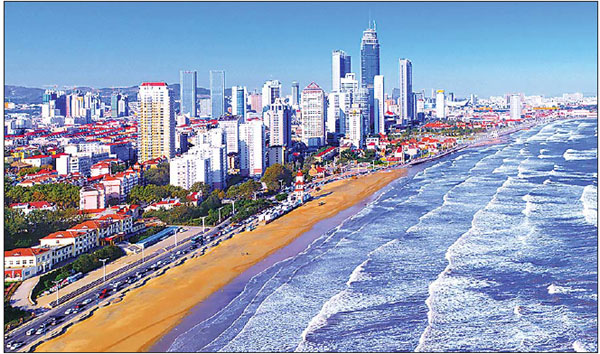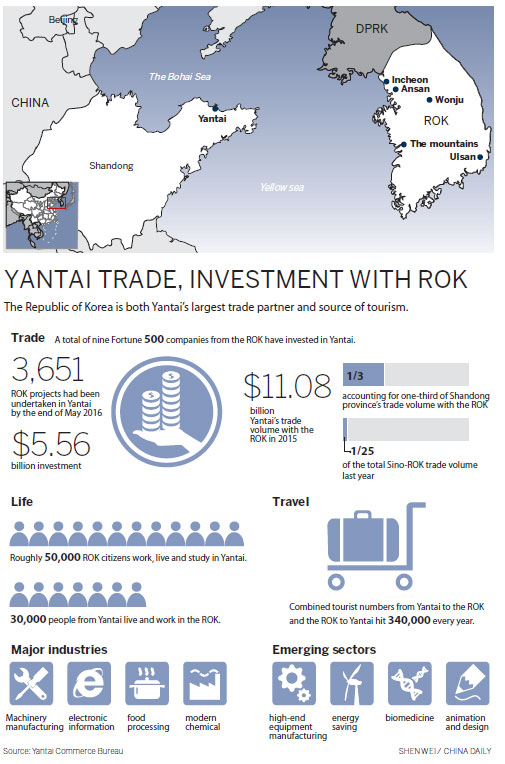FTA Sparks New Growth
Date: 2016-10-08, Source: China Daily, Total Visits :
ROK is Yantai's largest trade partner, major overseas source of investment Yantai, a coastal city in East China's Shandong province, is cashing in on the China-Republic ofKorea Free Trade Agreement, which was officially signed on June 1 last year, with expandingbusiness in e-commerce, healthcare, the creative industries and high-end maritime economy. The FTA, which is China's largest bilateral free trade agreement in terms of volume, focuses on17 areas, including trade in goods and services, healthcare, entertainment and investment, aswell as e-commerce and government procurement. "Yantai has really benefited and developed as a result of the FTA and the city has undergonegreat changes during the past year," said Zhang Yongxia, mayor of the city. "The ROK has become Yantai's largest foreign trade partner and its main source of foreigninvestment," Zhang told a group of journalists and photographers from ROK media outlets whogathered in the city last month. Statistics from Yantai's commerce bureau show the city's foreign trade with the ROK reached$11.08 billion last year, a year-on-year increase of one percent and accounting for 22.4 percentof the total foreign trade generated by Yantai last year. Located in eastern Shandong and geographically close to the ROK, Yantai has become apopular destination for leading ROK firms, including LG Corp, Doosan Heavy Industries andConstruction Co and Hyundai Motor Co. By May, 3,651 ROK-backed projects were underway in Yantai, involving utilized investment of$5.56 billion. These projects cover a wide range of fields, including textiles, electronics,machinery, food, maritime shipment and finance. Such growth and investment has continued this year, with contractual investments from ROKenterprises registering a year-on-year growth of 143.6 percent to reach $166 million during thefirst five months of this year, according to the commerce bureau of Yantai. Zhang said Yantai will continue to push for innovation and foster an international businessenvironment with advantageous policies, so that the China-ROK Yantai Industrial Park developsinto a hub for enterprises from the ROK. Covering 32 square kilometers, the China-ROK Yantai Industrial Park is focused on developingthe bioscience, intelligent manufacturing, auto manufacturing, marine technology and high-endservice industries. Yu Dong, director of Yantai's commerce bureau, said the industrial park will provide a platformthat will enable both countries to develop. A number of firms have already established facilities and undertaken projects or are currentlyestablishing a presence in the park. Asiana Airlines Inc opened a cargo distribution center in thepark in March; the first phase of Huaan Korea Town, which involves investment of 28.8 billionyuan ($4.72 billion) is under construction. Yang Li, deputy mayor of Yantai, said the city is currently transforming its industrial structure andis looking to move from equipment manufacturing to more high-end industries and servicesectors. The city aims to develop into a hub for ROK businesspeople to both invest and live in China andmake them "feel at home" in Yantai. Park Junghwan, editor-in-chief of Business Korea magazine, noted that under the strategy of"Two countries, two parks", the industrial park located in Yantai is now competing with someparks based in ROK and he urged Yantai to develop more industries with unique features inorder to attract investors. Contact the writers at zhaoruixue@chinadaily.com.cn, wangqian2@chinadaily.com.cn andyangcheng@chinadaily.com.cn South Koreans find home from home in Yantai Yantai's mayor Zhang Yongxia is often told by foreign visitors to the city that they are impressedby the city's strong "Korean elements", including road signs in both Chinese and Korean. To date, roughly 50,000 people from South Korea are living, working and studying in the city, andto the surprise of many outsiders, a growing number of South Koreans see Yantai as theirsecond home. This was echoed by Zhang Junhai, deputy director of the Huanghai Community, who said he wastouched by the fact that some South Korean residents, such as Jung Hoejin, principal of BOBTraining School, who lives in the community, register "return home" on airport arrival cards astheir "purpose of visit". In Huanghai Community, there are 128 South Korean families out of a total of 3,918, and 500South Korean residents out of the total of 12,600. There are South Korean cofeeshops, restaurants and schools run by South Korean people, and thenumber of businesses run by South Korean nationals is rising, according to Zhang. To better serve their needs, the community offices now offer Korean-language services. Han Inkyung, owner of the Ti Amo restaurant, said she has run business in the community for 10years and her business has grown rapidly despite the recent slowdown of the food servicesector. "More South Korean people have moved to the community and, as a result, Chinese people'slifestyles have undergone major changes in recent years," she said. "Both of these factors havebenefited my businesses." At the beginning of the year, construction began on a Korea Town, which is invested by HuaanGroup. The project involved investment of 117.3 billion yuan ($19.2 billion) and covers 20 squarekilometers. According to Li Guo'an, president of Huaan Group, the town, benefiting from the China-Republicof Korea Free Trade Agreement, is expected to become home to more than 200,000 SouthKorean people in the near future, which will make it the largest South Korean community in thecountry. The coastal city of Yantai, in East China’s Shandong province, has been trading with theRepublic of Korea for more than 2,600 years.

